Driving while drunk has been a serious public issue ever since 1967 when the Road Safety Act made it an offence to be in charge of a vehicle with a blood alcohol concentration of over 80mg of alcohol per 100ml of blood.
Up until then, drunk-driving was typically seen as a joke. Five years earlier, the Road Traffic Act of 1962 had created the offence of driving, attempting to drive or being in charge of a motor vehicle while the “ability to drive properly was for the time being impaired”. But with no legally established drink driving limit and no provision to measure alcohol consumption, this regulation was largely laughed off by motorists.
The 1967 Road Safety Act, however, was a milestone. Thanks to an extensive Government advertising campaign, in the changing social climate alcohol-related road deaths began to decline. The statistics are impressive, particularly as the total amount of UK road traffic was growing at an annual rate of 3%. By 1979, the year figures on drink-related road deaths began to be officially collected, the annual count was down to 1,640. It continued to decline through the next three decades and by 2009 had fallen to 380.
That’s still 380 deaths too many, of course. But progress.
Until a few years ago. In 2015, 200 road deaths were attributed to alcohol. But the following year the figure rose to 230. And it’s been on the rise ever since. Meanwhile, the Government seems to have been getting careless about monitoring motoring offences.
“The number of road traffic officers…decreased by 30% between 2007 and 2017,” says Hunter Abbott. He’s the managing director of AlcoSense, manufacturer of a range of breathalysers under that name. Abbott sees a direct link between cuts in Police budgets and increasing drink drive mortalities.
If the Police aren’t policing us adequately, do we need to take more responsibility ourselves? And could the answer be technology like the AlcoSense Pro personal breathalyser?
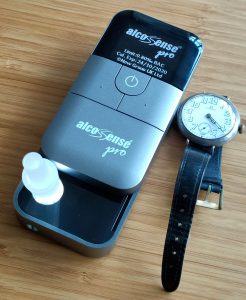 THE ALCOSENSE PRO IS A SENIOR member of a range of AlcoSense breathalysers that starts with a Single Use device at around £3 and tops out at around £250 with the AlcoSense Ultra*.
THE ALCOSENSE PRO IS A SENIOR member of a range of AlcoSense breathalysers that starts with a Single Use device at around £3 and tops out at around £250 with the AlcoSense Ultra*.
The device is small enough to be pocketable: when closed it’s 5.5cms wide, 10.5cms long and 2.7cms deep. To use it you slide it open, then simply follow the displayed instructions.
An initial setup procedure establishes the country you’ll be using it in (as regulations differ) and sets the time and date. When you travel abroad you can change the country. But the time/date parameter, once set, can’t be changed as it’s used to determine when the machine needs to be recalibrated (recommended annually). Recalibration involves sending the device off to AlcoSense and—for this model—costs around £30 for the standard service. You pay more if you want written certification and/or express turnaround.
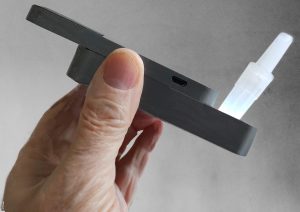
The Alcosense Pro with the mouthpiece inserted.
The first instruction is to install the mouthpiece. These are translucent plastic tube inserts that jam firmly into the receptor at the bottom left corner of the device. Their ingenious construction includes a one-way valve, to ensure that the breath of any previous user can’t be inhaled back from the device.
Alcosense sells a simpler and cheaper alternative called a blow tube which does the same job but without the one-way valve. The mouthpieces are individually wrapped and sold as a set of 20 for £9.99; the blowtubes come in a batch of 20 for £4.99.
That’s important because as you blow the screen will be showing control information in the form of two bars. How you blow and how long you blow can affect the result.
The upper bar indicates blowing strength and should be maintained at approximately the halfway point. If it gets too far past this point the green bar turns red, warning you that you’re blowing too hard. The lower bar shows blowing progress—once it hits 100% you hear a beep and the session is done.
After a brief pause for computation the screen will show you the result as a BAC ‰ value (breath alcohol content in parts per thousand).
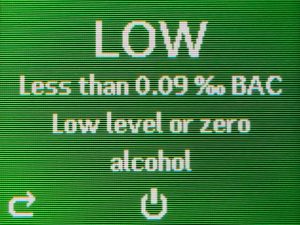
You should be hoping to see a screen like this.
According to AlcoSense if the device is properly calibrated this should be accurate to +/-0.02%, “similar to that of a police roadside breathalyser and around twice as accurate as most other products currently on the market at a similar price point”.
If you’re in the clear you’ll see a green screen, like the one on the left. Anything between 20% to 80% of your drink limit will show your BAC reading on a yellow caution screen. A BAC result that hits or exceeds the legal limit results in a red screen like the one on the right, with an icon warning you to stay away from your car.
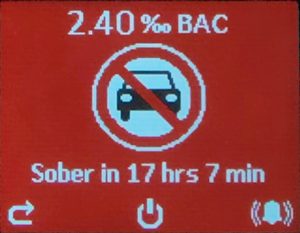
If you’re too drunk to read the digits, you’ll at least have noticed that the screen has turned red. Put your car keys back in the drawer.
With anything other than a low reading, the screen will offer an estimate of how long the alcohol will take to clear your system. AlcoSense emphasises that, unlike the precise BAC reading, this time estimate is a guess based on general assumptions about sex, weight and your overall health.
Results are stored in the machine with the exact date and time of the test. It would be useful to be able to tag these data with individual identifiers. But to do this you’ll have to maintain a table somewhere outside the device with the name of each individual against the time of the test.
You can read the test results out one by one on the built-in screen but you can’t extract the data from the device. The Pro has a microUSB receptor, suggesting it can be wired to a computer. There’s a Windows app you can download from the AlcoSense Web site called “Data Manager” to handle this USB connection. But in the case of the AlcoSense Pro this is just for firmware updates. Only the top end AlcoSense Ultra allows data to be downloaded, as a CSV (comma separated values) file, from the breathalyser into a PC.
The Alcohol Solution
My own scientific inclination suggests that the first step towards driving safely would be at least to quantify the effects of alcohol intake. Develop an evidence-based understanding of what drinking actually does to us. We know, of course, that a pint of strong lager is equivalent to three units of alcohol. But lagers differ in strength, and human bodies differ in size and weight.
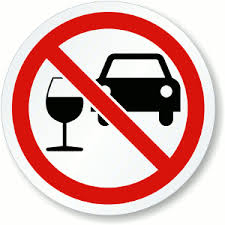 Measuring the percentage of alcohol in a drink is easy. We make the assumption that the drink is chiefly a mixture of water and alcohol: knowing the specific gravity of each of these we can deduce the alcohol content from the specific gravity of the mixture. A simple calibrated float (a hydrometer) can tell us this.
Measuring the percentage of alcohol in a drink is easy. We make the assumption that the drink is chiefly a mixture of water and alcohol: knowing the specific gravity of each of these we can deduce the alcohol content from the specific gravity of the mixture. A simple calibrated float (a hydrometer) can tell us this.
Measuring blood alcohol content can be done in the same way. You could extract blood and perform the equivalent of the hydrometer test. The specific gravity of human blood is around 1.06. Alcohol is much lighter at 0.78. So you deduce the BAC by measuring how much lighter the blood has become.
Blowing in a controlled manner into a device like the AlcoSense Pro conveys that breath and whatever molecules of alcohol it’s carrying, onto a fuel-cell sensor.
The Fuel-Cell Sensor
The job of any fuel-cell is to use the chemical energy in a fuel to create electricity. It does this by burning the fuel—that is to say, combining it chemically with oxygen, oxidation.
A typical breathalyser fuel-cell comprises a pair of platinum electrodes separated by a porous acidic electrolyte. The platinum catalyses a reaction between the air and any alcohol present, oxidizing it to, effectively, vinegar. The chemical reaction releases protons and electrons, which form a current through the electrodes. The stronger the current, the higher the concentration of alcohol.
Fuel cell sensors will also need calibration, but maintain their accuracy for considerably longer. This is particularly true if they’re in regular use—moisture in the breath actually helps maintain the sensor.
A fuel-cell sensor has a further advantage. Unlike semiconductor sensors, fuel-cell sensors aren’t affected by breath acetone, which means they won’t give false positives for diabetics or individuals who are fasting.
The AlcoSense Pro in Sulk Mode
Like us, the fuel-cell can be overwhelmed by too much alcohol. It’s designed to measure alcohol from the lungs, not the much greater residue of alcohol in the mouth and upper respiratory tract immediately following a drink. The device warns you not to test before 30 minutes has passed since your last drink.
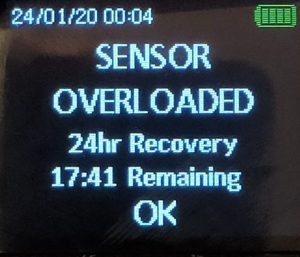 If you ignore this warning and the device detects an overload it will shut down with the warning shown on the right. Happily the sensor is able to recover once it’s had time to sleep it off, which takes about 24 hours. The warning screen shows you a count-down to that recovery and declines to operate during that time.
If you ignore this warning and the device detects an overload it will shut down with the warning shown on the right. Happily the sensor is able to recover once it’s had time to sleep it off, which takes about 24 hours. The warning screen shows you a count-down to that recovery and declines to operate during that time.
In common with many instruments, the accuracy of a fuel-cell is also affected by temperature. Here again, the AlcoSense Pro knows its limitations and if it finds it’s being invited to operate outside those limits it digs in its heels and refuses to play.
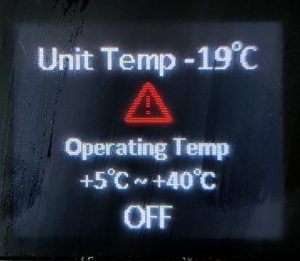
We tested this by treating the AlcoSense Pro to a short spell in the freezer. When subsequently switched on its display powered up long enough to display the screen on the left before hibernating. Once it was back within it’s operating temperature range of 5°C to 40°C it functioned again as normal.
It’s reassuring to know that you won’t be getting a false reading because the device is too hot or too cold or as drunk as you might be.
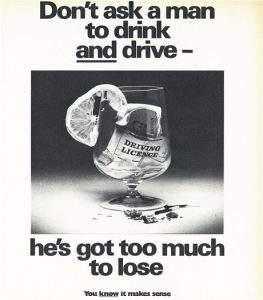
Changing Times
Introducing the breathalyser to radio audiences in 1967, Transport Minister Barbara Castle was challenged by the World This Weekend interviewer:
“Minister, this is a rotten idea. You’re spoiling my fun as a motorist… You’re only a woman, you don’t drive, what do you know about it?”
Does the AlcoSense Pro Make Sense?
On one level—absolutely.
If a police breathalyser shows you at or beyond the legal limit of 0.08%* while in charge of a vehicle you could be facing a driving ban, a fine of £2500 or 3 months in the clink.
But here in the UK we tend to use parts per hundred (%). A BAC of 0.08% is the same quantity as 0.8‰)
But it’s set me thinking. Bear with me…
Below that BAC of 0.8‰, you’re good to go. In England, Wales and Northern Ireland. Well, legally.
But this is the highest drink drive limit in the developed world. Which is to say most developed countries think it’s too high. In Scotland, for example, it’s 0.5‰.
This seems to be a more sensible figure, now that we have a better understanding of how alcohol works on our physiology and state of mind. Tests have shown that even at 0.6‰, key driving skills like our reasoning, depth perception, peripheral vision and recovery from glare, begin to be affected.
Over the Christmas break, Tested Technology used the AlcoSense Pro as a party trick. We had fun puffing away at it and one or two of us (names withheld to protect the innocent) ended up way over the limit.
At the time of writing, the AlcoSense Pro is currently on sale for £149.99.
Of course, it’s possible that you may have been drinking the night before, with no thought of driving, and then wake up next morning not knowing how much alcohol is still swishing around your brain, dulling your reflexes and fogging your vision. That could arguably be a use case for a breathalyser.
But otherwise, the AlcoSense may well turn out to be yet another of those ingenious modern gadgets you’ve discovered you’ll never use.
Chris Bidmead
